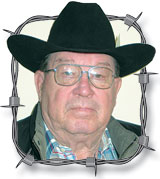For several year I was a diehard deer hunter.
Come September I would have had a handful of yellow permits. I would have dusted off my bow and been out to scout the woods.
I would even lift my bow out of the case and take a couple of practice shots at a Styrofoam target.
Hit it once, too.
I never really practiced enough. I was not proficient or terribly confident that I could fell a buck if he got within shooting range.
My best hope was that a deer would walk near enough my stand that I could deck it with a roundhouse swing of my bow, or leap out of a tree and pounce on its back like a big cat.
Or, I could have practiced more. But at $5 an arrow, I could’t afford to become too good.
When I bought my bow some years ago, I just about handed it back to them when I found out arrows would run me nearly $60 a dozen; but, I figured they would be a long term investment.
I didn’t count on losing half of them under my own backyard grass.
If I had worked much more on my proficiency, I wouldn’t have had enough arrows left to actually go hunting.
Anyone who hasn’t shot a compound bow might not understand. I didn’t.
For years I shot a recurve bow. I was used to seeing arrows fly in a nice arc, and stick in the ground with the vanes (feathers) sticking up, just like in those old cowboy and Indian movies.
Compound bows don’t shoot that way. Arrows fly flat and fast at 30 yards, and when they hit the turf they stay flat, disappearing faster than a night crawler under any hint of grass.
My cows located a couple for me last winter, stomping up the pasture after it had turned to mud. They weren’t much use, except for maybe shooting around corners.
Two or three I’ve never found; maybe someday, if I ever plow that ground, they’ll turn up in pieces, too.
Practiced or not, I was still in the woods the first chance I got, though I missed opening day (I like to take things one step at a time, and getting out there is the second big step; buying my tags was the first).
The next step is seeing a deer within shooting range. Until that happened, I didn’t have to worry about the following step – actually drawing back my string and letting fly with an arrow.
I reasoned back then, if I did get to that step, nothing on my deer tag said I had to follow through with it ( I’d probably spook him with the commotion of taking aim, anyway). I’d have to consider the cost if I missed. There’s another $5 arrow lost – more than that, actually, if you count the broadhead.
And if I were to hit the mark, well, that would open up a whole new box of Cracker Jacks. But, no need to fret over that, I thought. I’ll clean that fish – or deer –when I catch it.
I’d already taken care of the most important part. I bought my tags for archery and firearms seasons. Having handed over money for the privilege, I knew I’d make myself go deer hunting.
Instead of rushing to work early some mornings in October and November, I’d head for the deer woods. I would watch the sun come up over rusty oaks, be serenaded by morning birds, be scolded by red squirrels, feel the bite of frost on my cheeks, smell the musty aroma of damp leaves under my feet and thrill at the first sight of ghostly figures browsing in the timber.
For at least a couple of hours on several autumn mornings, I wouldn’t be answering any telephones or staring at a computer screen.
All of that came true in the three or four seasons I sat in trees with my bow, and I loved every day or it. But, the one shot I had I missed by a yard – probably saving myself a lot of tracking
In the end, as an archer I was never a deer slayer, just a deer watcher and waiter.
I had more success with my .30-.30, a few years ago I gave my bow to my son-in-law, I don’t know if it did him any good, either.
I’ve not been deer hunting at all the last couple of years. I reckon I just become lazy, unwilling to brave cold mornings and too cheap to pay the processing. I guess I’ve gone soft in my seventh decade, or more genteel, at least.
Beef, not venison, is what’s for dinner.
A former feature writer for Ozarks Farm and Neighbor, Jim Hamilton is a retired newspaper editor/publisher. Hamilton was reared on a small dairy farm in Dallas County, Mo. Contact Jim at [email protected].







